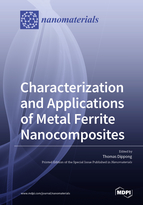Characterization and Applications of Metal Ferrite Nanocomposites
A special issue of Nanomaterials (ISSN 2079-4991). This special issue belongs to the section "Nanocomposite Materials".
Deadline for manuscript submissions: closed (20 December 2021) | Viewed by 21321
Special Issue Editor
Interests: nanocomposites synthesis; magnetic nanomaterials, doping; sol-gel methods; thermal analysis; spectrophotometric analysis; Co-Me-ferrite analysis
Special Issues, Collections and Topics in MDPI journals
Special Issue Information
Dear Colleagues,
In recent years, nanosized spinel-type ferrite has emerged as an important nanomaterial due to its high electrical resistivity, low eddy current loss, structural stability, large permeability at high frequency, high coercivity, high cubic magnetocrystalline anisotropy, good mechanical hardness, and chemical stability. Thus, research dedicated to the development and characterization of new promising materials, cost-effective, eco-friendly synthesis methods, and finding new applications for existing materials has received considerable attention. Metal ferrites MFe2O4 (M = Mn2+, Co2+, Ni2+, Mg2+, Zn2+) have been promoted as a novel group of versatile nanomaterials due to their tunable magnetic, electrical, and optical properties that make them appropriate for an extensive range of applications, such as magnetic recording and sensing, information storage, catalysts, permanent magnets, transformer cores, radiofrequency circuits, waveguide isolators, gas sensors, hybrid supercapacitors, ferrofluids, inductors, converters, antennas, antibacterial agents, biocompatible magnetic-fluids, controlled delivery systems, and medical imaging techniques.
This Special Issue focuses on ferrite-based nanomaterial synthesis and characterization including (i) synthesis, (ii) advanced chemical and physical characterization of structure, properties, and behavior, (iii) magnetic behavior, (iv) computational and theoretical studies of reaction mechanisms, kinetics, and thermodynamics, (v) applications of nanomaterials in environmental, biological, catalytic, medical, cultural heritage, food, geochemical, polymer, and materials science.
We invite authors to contribute original research and communication articles or comprehensive review articles covering the most recent progress and new developments in the field of metal-ferrite nanocomposites.
Dr. Thomas Dippong
Guest Editor
Manuscript Submission Information
Manuscripts should be submitted online at www.mdpi.com by registering and logging in to this website. Once you are registered, click here to go to the submission form. Manuscripts can be submitted until the deadline. All submissions that pass pre-check are peer-reviewed. Accepted papers will be published continuously in the journal (as soon as accepted) and will be listed together on the special issue website. Research articles, review articles as well as short communications are invited. For planned papers, a title and short abstract (about 100 words) can be sent to the Editorial Office for announcement on this website.
Submitted manuscripts should not have been published previously, nor be under consideration for publication elsewhere (except conference proceedings papers). All manuscripts are thoroughly refereed through a single-blind peer-review process. A guide for authors and other relevant information for submission of manuscripts is available on the Instructions for Authors page. Nanomaterials is an international peer-reviewed open access semimonthly journal published by MDPI.
Please visit the Instructions for Authors page before submitting a manuscript. The Article Processing Charge (APC) for publication in this open access journal is 2900 CHF (Swiss Francs). Submitted papers should be well formatted and use good English. Authors may use MDPI's English editing service prior to publication or during author revisions.
Keywords
- Ferrite nanocomposites
- Metal doping
- Mixed ferrites nanomaterials
- Synthesis methods
- Thermal behavior
- Magnetic properties
- Photocatalysis
- Nanomedicine
- Nanotubes







